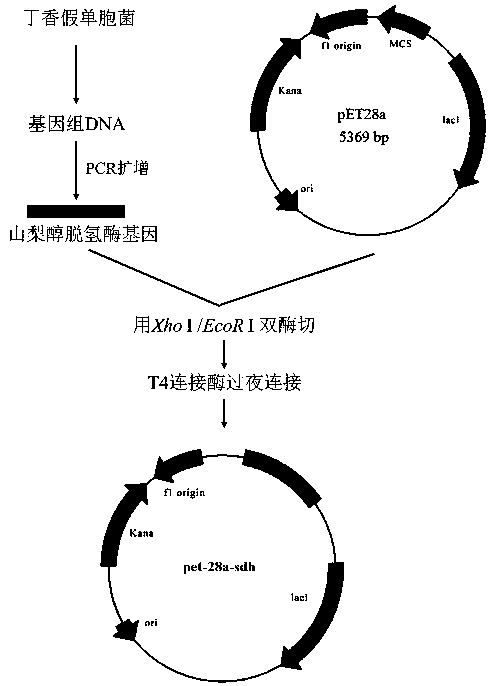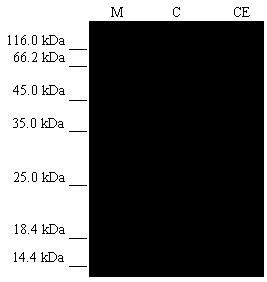A kind of sorbitol dehydrogenase gene derived from Pseudomonas syringae and its application
A technology of sorbitol dehydrogenase and Pseudomonas, which is applied in the fields of genetic engineering and enzyme engineering, can solve problems such as unsuitable for industrial application, low activity, and difficulty in distinguishing xylitol, and achieve important industrial application value and transformation high rate effect
- Summary
- Abstract
- Description
- Claims
- Application Information
AI Technical Summary
Problems solved by technology
Method used
Image
Examples
Embodiment 1
[0031] Example 1 Cloning of sorbitol dehydrogenase gene
[0032] Pseudomonas syringae was purchased from the China General Microorganism Culture Collection Center (CGMCC), medium LB (g L -1 ): Yeast extract 5 g, peptone 10 g, NaCl 10 g, add distilled water to 1 L.
[0033] Pseudomonas syringae was inoculated in 5 mL LB liquid medium and cultured at 30°C until logarithmic growth phase, and the genome of Pseudomonas syringae was extracted using DNAKit (TIANGEN, China). The primers used to construct the expression vectors are provided with enzyme cutting sites, and the primer sequences are as follows:
[0034] Upstream primers (SDH-sense containing EcoR I) is:
[0035] 5'-CG GAATTC AAACGACTTGAAGGTAAAAGCG-3'
[0036] Downstream primer (SDH-anti containing xho I) is:
[0037] 5'-CCG CTCGAG TCAGTTCATCCAGTTGCCACCA -3'
[0038] All primers were synthesized by Nanjing GenScript Biotechnology Co., Ltd. PCR conditions of the gene: Denaturation at 94°C for 7 min, followed by 3...
Embodiment 2
[0039] Example 2 Recombinant expression vector pET-28a- sdh build
[0040] use xho Ⅰ and EcoR Ⅰ Respectively digest pET-28a (purchased from Novagen Merck China) and the amplified target gene containing two restriction sites (obtained by PCR amplification in Example 1), and recover the double-digested target fragment and express Vector, the expression vector pET-28a that has been digested with two enzymes and the target gene (the gene shown in SEQ ID NO: 1) were connected overnight with T4-DNA ligase (purchased from TaKaRa Company) to obtain the recombinant vector pET-28a- sdh ; Add 10 μL of the ligation product to 100 μL of Escherichia coli BL21 competent cells, place on ice for 30 min, and heat shock at 42°C for 90 s. Place on ice for 2 min. Add pre-warmed 0.45 mL SOC medium (2% (W / V) peptone, 0.5% (W / V) yeast extract powder, 0.05% (W / V) NaCl, 2.5 mM KCl, 10 mM MgCl 2 , 20 mM glucose. ). 220rpm, 37°C, 1h. Add 200 μL of the bacterial solution to the LB plate contai...
Embodiment 3
[0041] Example 3 Induced expression of sorbitol dehydrogenase gene in Escherichia coli BL21
[0042] pick recombinant bacteria E. coli BL21 (containing pET-28a- sdh ) and control bacteria E. coli BL21 (containing pET-28a) was added to LB liquid medium containing 30 μg / mL kanamycin, and cultured overnight at 37°C with shaking. Then they were inoculated into fresh LB liquid medium containing 30 μg / mL kanamycin according to 2% inoculum amount, and cultivated to OD at 37°C. 600 At about 0.6, add IPTG to a final concentration of 0.2 mmol L -1 , 16°C, 220 rpm, after induction of expression for 24 h, centrifuge (4°C, 5000 rpm, 15 min), resuspend the bacteria sludge with 100 mM Tris-HCl buffer (pH 9.0), and sonicate the cells (power 300 W, ultrasonic 3 s, 5 s intermittent, 5 min in total), centrifuged (4°C, 12000 rpm, 15 min). SDS-PAGE analysis showed that the recombinant bacteria E. coli BL21 (containing pET-28a- sdh ) expresses a protein with a molecular weight of abo...
PUM
 Login to View More
Login to View More Abstract
Description
Claims
Application Information
 Login to View More
Login to View More - R&D
- Intellectual Property
- Life Sciences
- Materials
- Tech Scout
- Unparalleled Data Quality
- Higher Quality Content
- 60% Fewer Hallucinations
Browse by: Latest US Patents, China's latest patents, Technical Efficacy Thesaurus, Application Domain, Technology Topic, Popular Technical Reports.
© 2025 PatSnap. All rights reserved.Legal|Privacy policy|Modern Slavery Act Transparency Statement|Sitemap|About US| Contact US: help@patsnap.com


